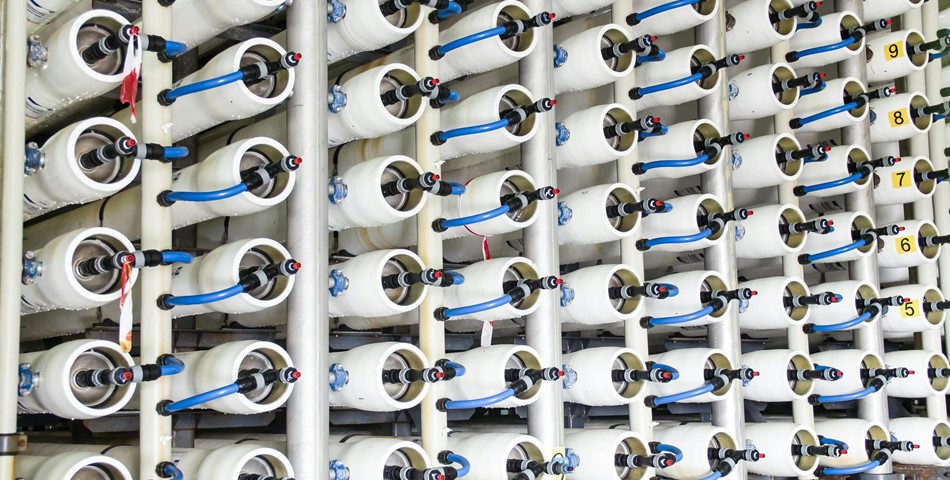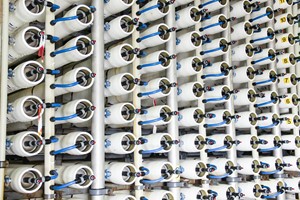Given the significance of this topic and the growing interest among Jordan's top leaders in various events and conferences, His Majesty's speech at the recent climate change conference in Dubai (COP28), along with meetings with the government and relevant authorities, underscored His Majesty King Abdullah II bin Al Hussein and Crown Prince Al Hussein's emphasis on Jordan's water security, the effects of climate change, and other water-related issues, including diplomacy, adaptation, and desalination.
The Royal Water Committee in Jordan recommended the acceleration of the national carrier project, and His Majesty the King instructed the government to prioritize desalination projects and to overcome obstacles to provide water to the Kingdom's governorates through seawater desalination. This has prompted me to write the following article, which evaluates desalination and advises on how to expedite Jordan's entry into the world of desalination.
Jordan, the second poorest country in terms of water resources, has nearly exhausted all possible solutions to coexist with its critical water situation. The naturally poor dry climate, scarcity of available water resources, rapid and unpredictable population growth due to waves of refugees, and the negative impact of climate change on precipitation amounts and distribution patterns during the rainy season exacerbate the issue. According to my recent drought analyses, drought occurrence is projected to increase every 25 years, with an average normal drought of 2-3 years and a severe drought every 8–11 years. Climate change further reduces the availability of natural resources (groundwater, surface water). This has led to a rapid decline in conventional water resources, parallel to a highly overexploited groundwater usage (three times the groundwater safe yield), decreasing future exploitability.
The continuous rapid depletion of groundwater levels (SWL) due to excessive extraction far surpasses the safe yield. Serious issues with transboundary aquifers, even if resolved with maximum advantages to our needs, cannot address our water shortage concerns.
As a result, Jordan's water sector leadership has proven in recent years that seawater desalination is the only viable option after prioritizing the reduction of non-revenue water (NRW). Unfortunately, NRW accounts for about half of the water supply due to the need for rehabilitation, changing public attitudes about water, and incorporating water ethics into the educational system (from one of my previous hydro-social studies in the Jordan basin, Gazal 2022).
Desalination technology has ancient roots. From 3200 BC to 1100 BC, historians believe that Minoan sailors, a Bronze Age Aegean society in the Mediterranean, carried out the earliest crude adaptation of desalination in recorded history.
In simple terms, desalination is the process of removing salts from water to make it suitable for drinking, agriculture, or industrial purposes. Desalination began in its most basic form by heating water, condensing steam, collecting it, and using it for drinking. Initially, its applications were limited to maritime transit and naval military forces.
The first documented attempt to use desalination on land to produce drinking water occurred in Al-Kandasa, Jeddah, Saudi Arabia, in 1905 (some sources say 1907) when a Turkish battleship ran aground off the coast of Jeddah. The desalination unit was taken out and operated, remaining operational intermittently for two years until it completely stopped.
In Qatar, desalination was used in the mid-1950s, with limited attempts in 1952, but the first feasible desalination unit in the world was operated in 1957 in Kuwait with two MSF flash distillation units. Desalination technologies abound, but reverse osmosis (RO) is the most common and today accounts for more than 70% of total production.
Large commercial-scale desalination began in 1965, with a worldwide capacity of about 8000 m3/day in 1970. In 2013, desalination produced about 72 million m3/day of desalted water from about 16,000 facilities worldwide. Many researchers suggested that within 10 years, production is forecasted to triple with an expected investment of around $60 billion. In 2018, there were more than 17,000 desalination plants worldwide, producing over 200 million m³ of water daily. According to Straits Research, "The global water desalination market size was valued at USD 19.62 billion in 2022."
A United Nations World Water Development report indicates that only 1% of the world's water is desalinated. The Ras Al Khair desalination plant in Saudi Arabia produces 1,036,000 m3/day using RO. Many Gulf countries now largely depend on desalinated water for their inhabitants' consumption: in the United Arab Emirates (UAE), 42% of drinking water comes from desalination plants producing more than 7 million cubic meters (m3) per day; in Kuwait, it is 90%; in Oman, 86%; and in Saudi Arabia, 70%.
As freshwater scarcity grows in various regions of the world, desalination is becoming increasingly important in supplementing local water supply. Desalination plants can be profitable and sustainable commercial enterprises with the right investment and management. Looking ahead, desalination technology, particularly RO, will remain a significant source of fresh water for many Middle Eastern countries.
Desalination should be considered a viable method for providing freshwater for municipal and industrial use in many emerging Asian and African countries. Jordan, the world's second poorest country in terms of water resources, faces rising pressure on its limited supplies due to large refugee flows and the effects of climate change on the annual precipitation.
Given the fluctuations in rainfall and changes in its distribution, seawater and/or brackish groundwater desalination is the long-term solution to Jordan's water resource challenges and the sustainability of development across all sectors in one of the Middle East's promising developing economies.
The Jordan Ministry of Water and Irrigation (MWI) and its water utilities cannot sustain and improve water supply without diversifying nontraditional water sources. Many left brackish groundwater wells are potential future water resources, especially in the Azraq basin and the eastern part of Jordan. Local small desalination plants in these areas may be a better investment than constructing and exploring new groundwater wells, which would only address increasing salinity in the renewable aquifer due to excessive pumping beyond the safe yield and decreased natural replenishment from the region's low annual precipitation of less than 100 mm/year, classifying it as an arid climate.
Currently, Jordan's harvesting of precipitation water has reached its peak efficiency. Further investment in large-scale projects would increase costs, although small-scale water harvesting projects are still desirable (for example, the FAO, UNDP, GGGI, and several relevant ministries and institutions are implementing a 7-year GCF green climate fund project in southern Jordan to increase new water supplies through wastewater recycling and rainwater harvesting).
Following the challenges of the Red Dead Canal project, the Water Desalination and Transmission Project Aqaba-Amman (National Carrier) has emerged as the country's most important strategic water project. The first phase of the "National Carrier" project, which desalinates Red Sea water from Aqaba in the south and transports it to the Kingdom's northern governorates, will cost over a billion dollars and produce between 250 and 300 million cubic meters of drinking water.
Concerns have been raised about the success of seawater desalination in Jordan, citing the cost of transporting water from Aqaba, the only seawater source, to residential areas in the north. Some speculate that the failure of the Red-Dead Sea project should have redirected attention from desalination to other solutions. However, desalination remains the best available solution, which must be developed and expanded to ensure the sustainability of Jordan's water supply.
Jordan's biggest challenge is the high cost of desalinating sea and brackish water. This poses a significant obstacle to the long-term convergence of supply and demand. A higher-level steering team, including Jordanian water resource management professionals, is needed to overcome obstacles and achieve project success while meeting the country's water sustainability goals. Raising water supply prices may serve three additional goals: 1) reducing water demand and encouraging saving, 2) financing current and future desalination projects or research and development (R&D) activities, and 3) increasing control over water usage.
My suggestion is to conduct a comprehensive eco-social investigation study before making any decisions in this regard. It is also important to ensure that Jordanian water supply standards are flexible and promote better management choices for different water supply purposes.
To conclude, desalination, among all non-traditional water resources, should be properly considered and prioritized in Jordan's future water security plans. For Jordan, desalination of seawater is the only sustainable means of survival. However, to reduce costs, which are roughly $3 per cubic meter of water, renewable energy must be used.
Adopting lower but suitable water quality standards for desalinated water, as seen in Gulf countries, allows for flexible criteria and variability in desalination options and mechanisms. This permits the use of desalinated water for general purposes, while potable water, requiring higher standards, incurs higher costs. This approach reduces costs and prevents the loss of drinkable water.
Given Jordan's limited experience in seawater desalination and lack of specialized expertise, it is crucial to update local universities' study plans for water-related disciplines to include courses on desalination techniques. Encouraging scientific development and improvement of desalination techniques, membranes, and energy efficiency, supplemented by renewable resources, is also essential.
The involvement of specialists and elites in the academic sector can significantly impact the water sector's decisions, ensuring they are based on scientific principles and avoid potential mistakes. The engagement of senior water resources experts in the desalination follow-up project committee is necessary and adds value to Jordanian efforts to achieve water security.
By Dr. Osama Moh’d Najeeb Gazal











